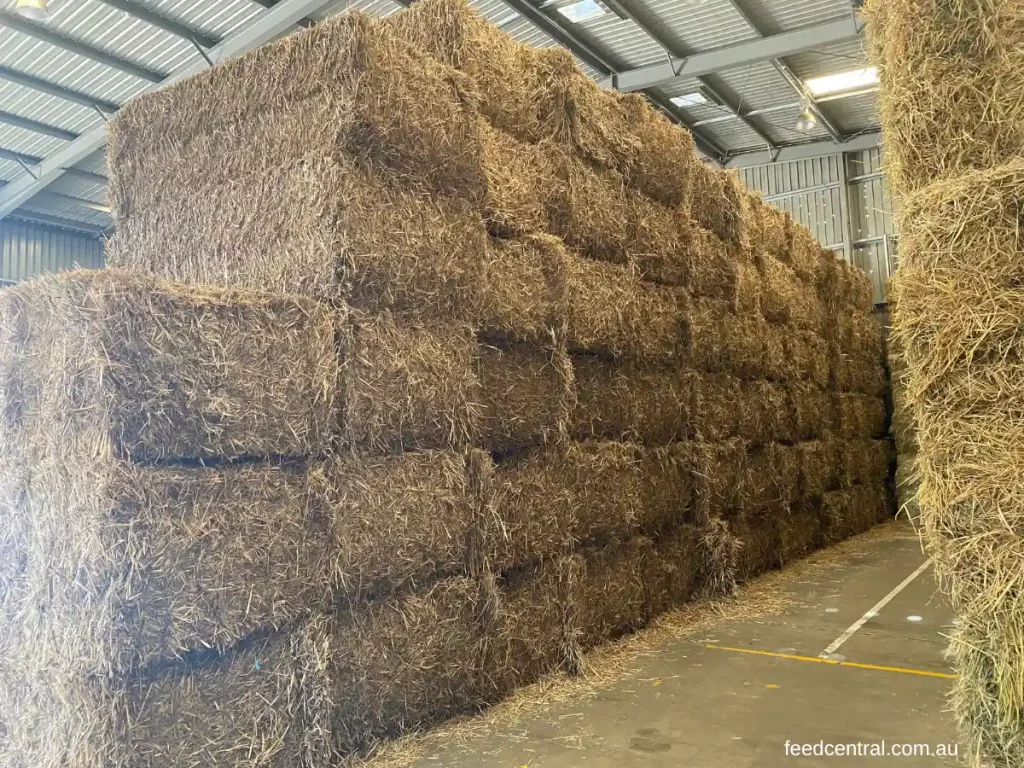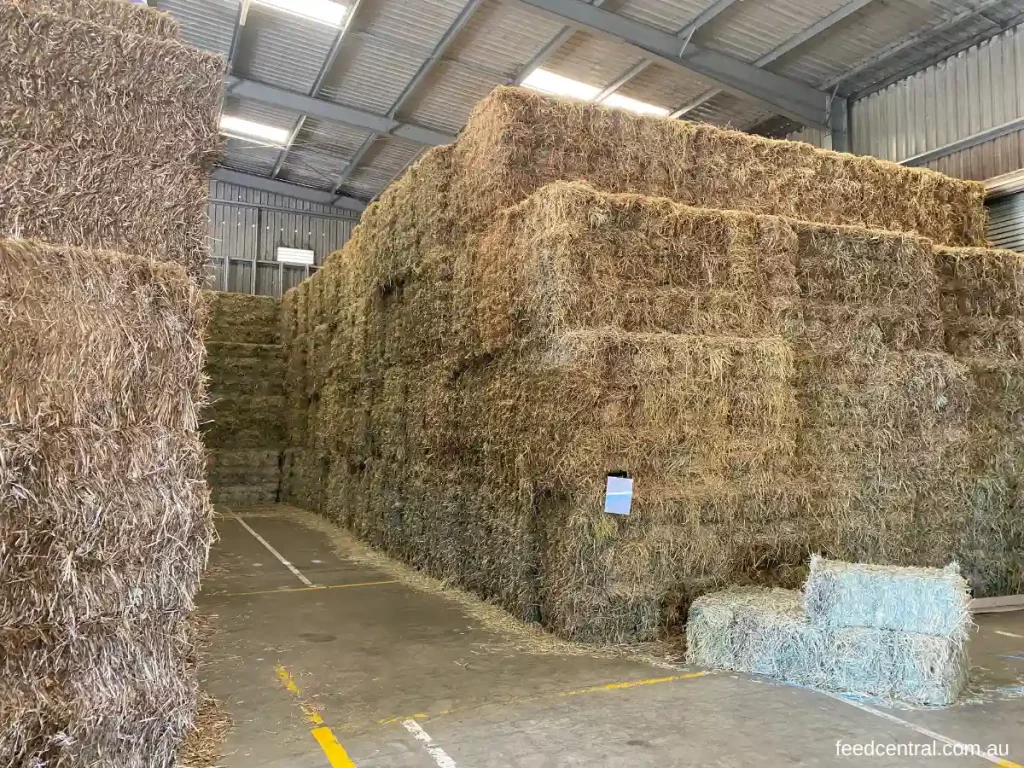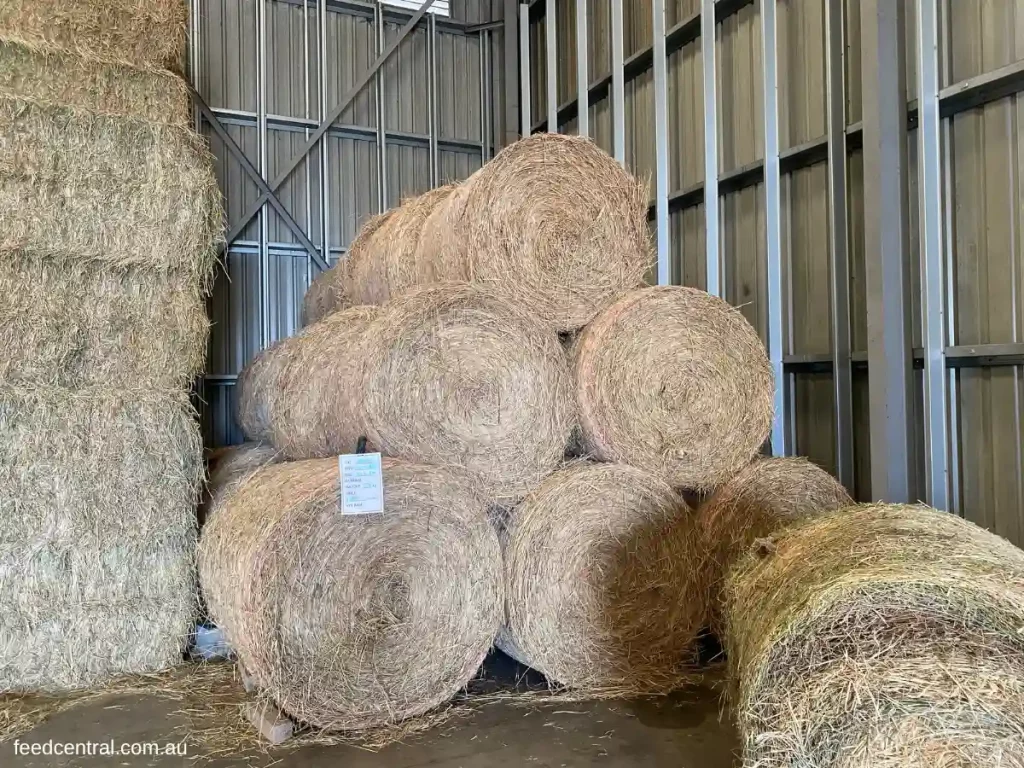As your hay importation and exportation business grows, the amount of hay you’ll store on your farm or facility will as well. The time will inevitably come for you to stack hay bales to make more space. How do you do this?
When stacking hay bales, ensure that each bale sits evenly on the one below in order to maintain a straight, neat stack. Turn bales as needed to ensure they are sitting flat. By doing so, your hay stack will remain upright and won’t pose the risk of falling. Don’t over-stack, avoid power lines, and always stack on level ground.
In this guide to stacking hay bales, we’ll share all our favourite tips, tricks, and techniques so you can create haystacks safely and efficiently. You’re not going to want to miss it!

How Do You Stack Hay Bales?
This is the million-dollar question. Exactly how do you stack bales so the haystack is stable? If you’re working with large, square-shaped stacks of hay, here’s what we’d recommend.
Start with a Good Foundation
As when building anything, a solid foundation for stacking hay is integral. You want to select a flat, level, even surface for the first bale of hay to go.
If the ground is uneven or on a slight slope, then the integrity of the hay bale is now debatable. As you’re stacking the hay, it could fall.
This can be a very scary situation. While it would depend on what else is in the barn or the warehouse, the hay can break equipment, injure livestock, or even come toppling down on you.
Being directly impacted by falling bales could cause serious injury and possibly even death if the hay bales are large enough or fall from a great enough height.
Determine the Size of the Stack
Before you begin stacking, you want to plan how many bales of hay you’ll stack on top of one another. Now is also a good time to sort the hay by size, as this will certainly make stacking a more expedient and efficient job.
Start Stacking Wider Hay Bales
Take your largest, widest bale of hay and place it on the ground level. This bale will serve as the foundation on which you’ll continue building the stack.
Go Narrower
As the stack builds, you want to decrease the size of the bales as you get closer to the top. Between the wider bales and the narrower ones, you should be alternating the layers to create an overlap of at least half a hay bale around the stack’s perimeter.
Know When to Stop Stacking
When do you stop stacking hay? The answer is not necessarily when you run out of bales. Instead, if the stack height is 1.5 times greater than the base width, the stack is tall enough.
Even if you have additional bales that you wanted to stack, you’ll have to find wider bales and start another stack. This one is done. If you keep pushing it, the hay could fall.
This video shows how to stack hay with the assistance of heavy machinery. Be sure to check it out!

What Is the Best Way to Stack Round Hay Bales?
Here are some stacking options you can use as well as the pros and cons of both.
Stacked in a Row
If you’d rather not stack the hay, per se, then you can always arrange your rounded bales in a long row.
Place the bales end to end but be sure to space out rows at least three feet from one another.
Stacking hay in a row is an excellent option if you want to dry a lot of bales quickly. However, you will have to use quite a handful of tarps to protect your hay from the elements when drying out the bales.
Plus, organizing round hay bales in this fashion requires a lot of space. You’d more than likely have to dry the bales in a field as opposed to inside a warehouse or a barn. The only exception is if you only have a couple of bales to dry.
Even then, storing the bales long-ways in a barn or warehouse would pose a tripping hazard.
Stacked in a Pyramid
Alternately, you can stack round hay bales in a pyramid. This would require some sort of blocks or stakes on the outside of the bottom bales to prevent them rolling outwards. We have found that the extra weight from the bales above, does cause some shape distortion throughout the bottom bales.

Stacked On Their Ends
Round bales stacked on their ends, provides the best long term stacking solution because the bales maintain their shape and can be stacked higher than the above methods.
The challenge with stacking round bales on their ends is you will need a proper set of hay grabs rather than forks to do this. Not everyone has these available hence why this method of stacking is a little less common.
Should You Stack Hay Bales on Pallets or Directly on the Floor?
Whether your hay bales are round or rectangular, either way, one or more bales have to go on the ground.
You know that the ground should be level, but is it wise to put hay directly on the ground or should you elevate the hay on a pallet?
Using pallets to put hay on is a good idea but will be unsuitable for most people due to the sheer number of pallets needed. Using pallets allows good air flow under the bales and prevents moisture from being sucked up by the bales. This is really only necessary for stacking directly on the ground. Stacking bales directly onto a concrete floor is best.
Other Hay Stacking Techniques
We’ve already presented several hay stacking techniques, and we thought we’d share two more that you can use depending on the size of the hay you need to stack.
Interlocking Hay Bale Method
When stacking small square or rectangular hay bales, the technique starts the same as how you’d arrange larger bales.
Find the widest bales and place them on the pallet first, then add the narrower bales atop that.
Be sure to create interlocking alternate layers, rotating the layers as you stack. The key is to place the bales like you’re laying bricks so that each bale is secure.
Crisscrossing Hay Bale Method
For larger bales, ideally in a square or rectangle shape, you can also rely on the crisscrossing method.
You want to crisscross the hay bales over top of one another, layering the bales so that they face one direction in the first row and then an alternate direction in the next row.
It’s okay if the bales aren’t as tightly packed as when interlocking the bales, as this will allow airflow to permeate.
Safety Tips for Stacking Hay
To wrap up, we want to impart to you the following safety tips. Please always keep these tips in mind when stacking hay, whether you’re doing it manually or using machinery to aid you.
Don’t Use More Than 10 Bales Per Stack
You already know that the haystack you create shouldn’t exceed the width of the base by more than 1.5 times. To ensure your hay stays within that limit, you don’t want more than 10 bales per stack.
Don’t Stack Hay Near Power Lines
If stacking your hay bales outdoors, you never want to place the hay directly underneath power lines. You could risk driving into or getting your heavy machinery entangled in the power lines when working, which could be very dangerous.
Test the Hay for Moisture
Given what you know about how moisture levels can rise in hay if it’s exposed to inclement weather as well as how the bottommost layers of a haystack can accumulate more moisture, it’s a good idea to do moisture tests regularly.
We’ve discussed how you do this on the blog, so be sure to give that post a read. See our post on how to check the moisture in you hay.
Tell Kids Not to Play on the Hay
Our last tip is this. If you have children, teach them that haystacks are not toys. They should never be allowed to climb or play on even one bale of hay, let alone a bunch.